Affiliate links on Android Authority may earn us a commission. Learn more.
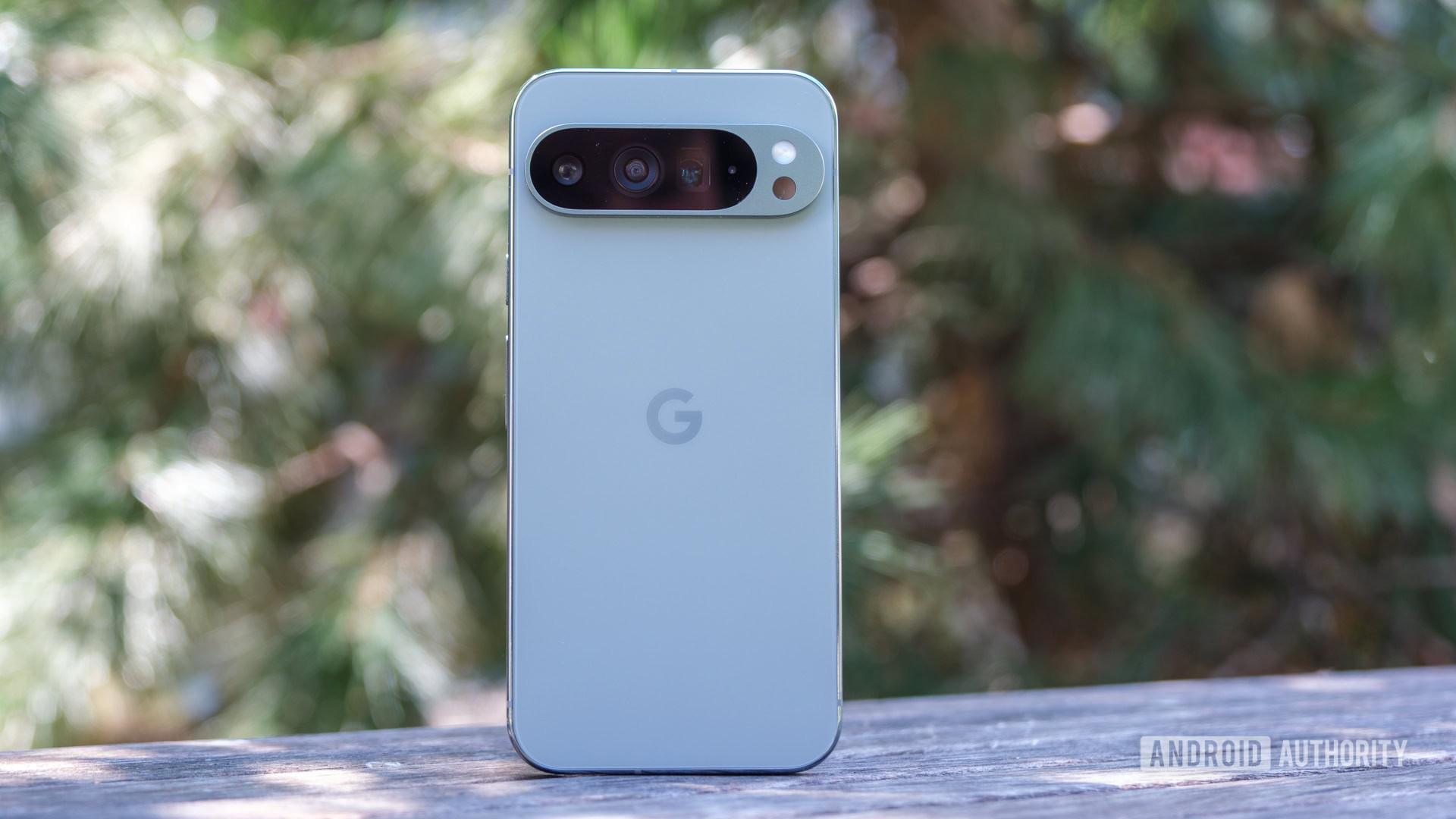

The Pixel 9 Pro XL is everything I hoped Google could achieve, and then some
Published onFebruary 21, 2025

Google Pixel 9 Pro XL
MSRP: $1,099.00
What we like
What we don't like

Google Pixel 9 Pro XL
I’ve always had what could probably be described as a foolish belief in the Google Pixel series. Ever since my college roommate returned from Christmas break with a Pixel XL in its Really Blue finish, I thought Google would eventually have the best Android phone around. A bold hope, I know — Google seems to kill off its best products just as they reach their peak — but I believed it nevertheless. Sure, there have been stumbling blocks and one-off features, but I think my faith has finally paid off. The Pixel 9 Pro XL might be the best Android phone I’ve ever used, and it’s Google right down to the core.
Google finally perfected its design
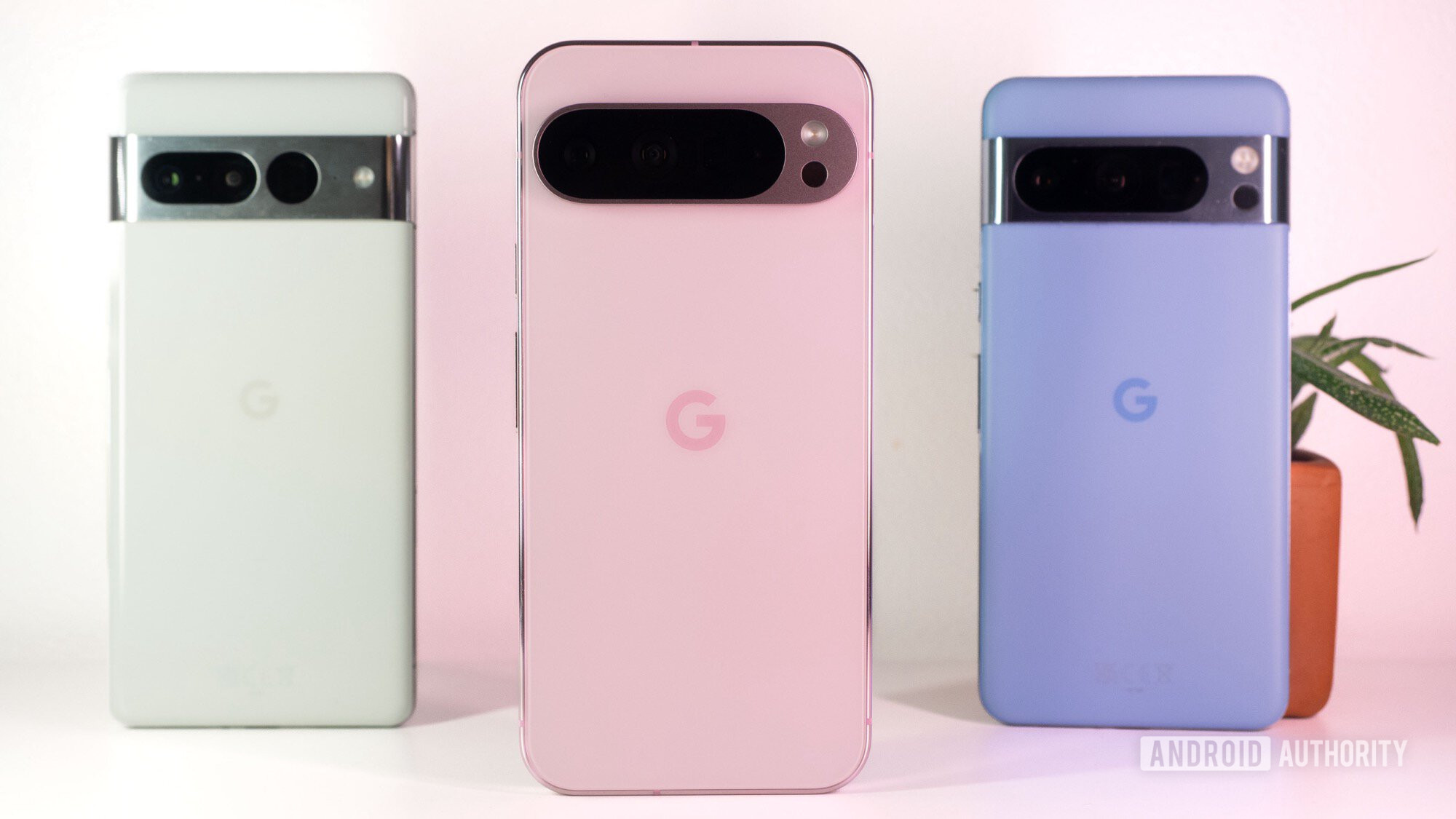
For whatever reason, my love for the Pixel series didn’t start with its near-stock flavor of Android — it started with Google’s design. I know, you should probably like how using your phone feels over how it looks, but that just wasn’t me. I was drawn in by the rear-mounted fingerprint sensor, two-toned finishes (still waiting on another Panda, Google), and the sweet simplicity of the G logo on the back.
Then, I watched the Pixel evolve. I watched Google adopt a larger, square camera bump, tack on a display notch that’s impossible to forget, and ditch the beloved rear fingerprint sensor — some changes I liked and some that I didn’t. Once Google introduced a brand-new design with its now iconic camera bar with the Pixel 6 series, though, I finally felt like it was building towards something. It had created an Android flagship that was completely different from what the likes of Samsung, Motorola, and OnePlus were doing, and people finally started to ask what phone I was using purely based on its looks.
The Pixel camera bar has become an all-inclusive island, and life is good.
Now, that unique, ambitious design has matured with the Pixel 9 series. Gone are the curves — both at the edges of the display and around the aluminum frame — and the camera bar has morphed into more of a camera island, trading the possibility of a two-toned Pixel for the security of a camera bump that wouldn’t shatter if dropped on an edge. It’s a design evolution that I cheekily said makes it my favorite iPhone ever, and I’m willing to stand by that fact. No, it’s not literally an iPhone, but the Pixel 9 Pro XL finally matches Apple’s lofty hardware standards in a way that feels sturdier and more reliable than Google’s previous flagships.
Every edge of the Pixel 9 Pro XL feels carefully considered, with just enough curve at the edges to make the massive 6.8-inch AMOLED panel decently comfortable to hold and just enough texture to the frosted Gorilla Glass Victus 2 back panel so the phone shouldn’t slip right out of your hand. If it does, at least the IP68 rating should guard it from the elements. Both panes of durable glass are joined by a color-matched high-gloss aluminum frame that looks stunning but might work against Google’s largest flagship — at least if you have smaller hands. The shift from slightly rounded rails to perfectly flat ones makes the Pixel 9 Pro XL feel thicker than the preceding Pixel 8 Pro, even though it’s about a third of a millimeter thinner at its widest point and is nearly the same height and width. If you’re worried about that size, though, Google has a long overdue smaller Pixel 9 Pro to sell you, though either way, you should buy a case for some added peace of mind.
Outside of the new, flattened sides, the Pixel 9 Pro XL is a tale of small changes that add up to a significant improvement. As mentioned, it has nearly identical dimensions to its predecessor, yet it adds an extra tenth of an inch of display real estate. What that means is that the Pixel 9 Pro XL has slimmer (but still even) bezels all around. They’re slim to the point where you won’t notice them — at least, I didn’t — yet the flattened frame means you won’t accidentally tap the edges of the display, either. Google’s upgraded panel is brighter, too, peaking at 3,000 nits rather than 2,400 and holding 2,000 nits in high-brightness mode instead of 1,600. Even the color options on the Pixel 9 Pro XL feel a bit more grown up, with muted tones like Rose Quartz and Hazel replacing Mint and Bay. They still look good, but they’re not quite as vibrant as I’m used to.
Around the back, even the island-like camera bar fits perfectly on the Pixel 9 Pro XL. As much as I liked the visor-style bar on the previous Pixels, I’ve found it easier to position my fingers around the island, resting one comfortably underneath to support such a big phone. The slight texture of the aluminum helps, too, as I can feel it and know that I’m not smudging my camera lenses. I might smudge the temperature sensor, but I’ve ignored that feature as much as Google ignored it while launching the Pixel 9 series.
Jokes aside, it’s remarkable how far Google has come in just three years. I was impressed with the new design when it launched on the Pixel 6 series, yet holding the Pixel 6 Pro next to the Pixel 9 Pro XL makes the former feel like little more than a proof of concept.
Tensor G4 benchmarks aren’t great
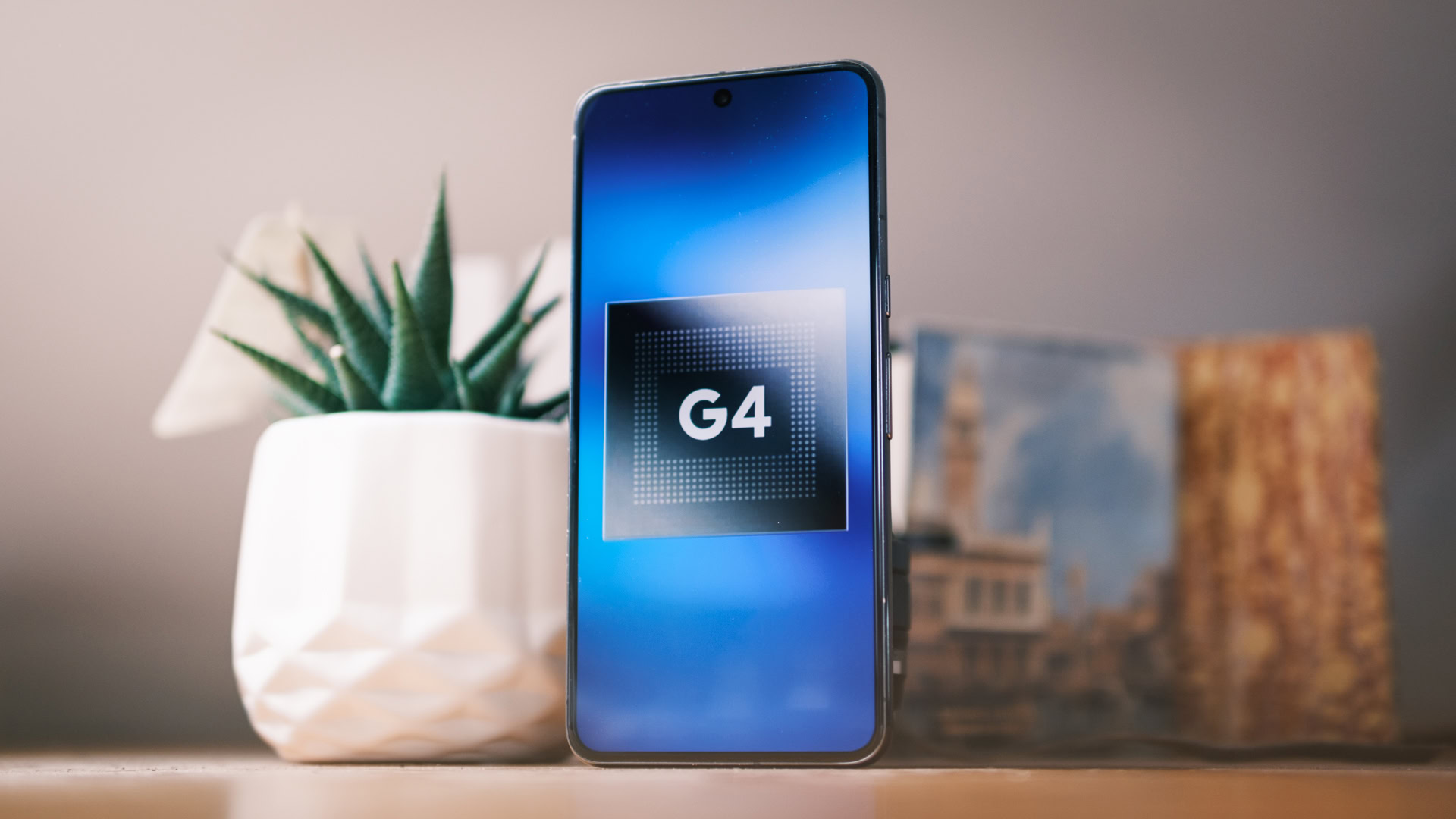
Of course, we can’t continue a Pixel-based discussion without talking about what’s probably the Pixel 9 Pro XL’s most important feature. No, it’s not the triple-camera setup — it’s the Tensor G4 chipset. This year, it comes backed by a whopping 16GB of RAM (13GB that you can use and 3GB that’s just for Gemini) and packs higher clock speeds across most of its eight cores. Despite those all-important upgrades, though, the Pixel 9 Pro XL still only comes with 128GB of storage in its base configuration, because reasons. Come on, Google, even Samsung doubled the base storage on its Galaxy Z Flip 6, and it doesn’t have as many cameras to capture from or ready-to-go AI features to power through.
Anyway, I digress because we all know that the Tensor’s raw performance isn’t why it matters, it’s all about the software capabilities it unlocks. Before we get to those, we still have to benchmark Google’s latest in-house chipset. I ran it through our usual gauntlet of CPU, GPU, and battery tests against similarly equipped Android flagships and Apple’s top dog, and the results are anything but surprising. The Tensor G4 came up short of everything except the Tensor G3 in both Geekbench 6 and across 20 runs of 3D Mark’s Wild Life test. To Google’s credit, it’s closing the gap on the OnePlus 12 and its standard Snapdragon 8 Gen 3 chipset, but it still has a lot of work to do to catch Apple and Samsung. That real performance upgrade sounds like it’ll have to wait for the Pixel 10. Worse, the Pixel 9 Pro XL has now been further eclipsed by phones like the OnePlus 13 and Samsung Galaxy S25 series, both of which carry Qualcomm’s Snapdragon 8 Elite chip.
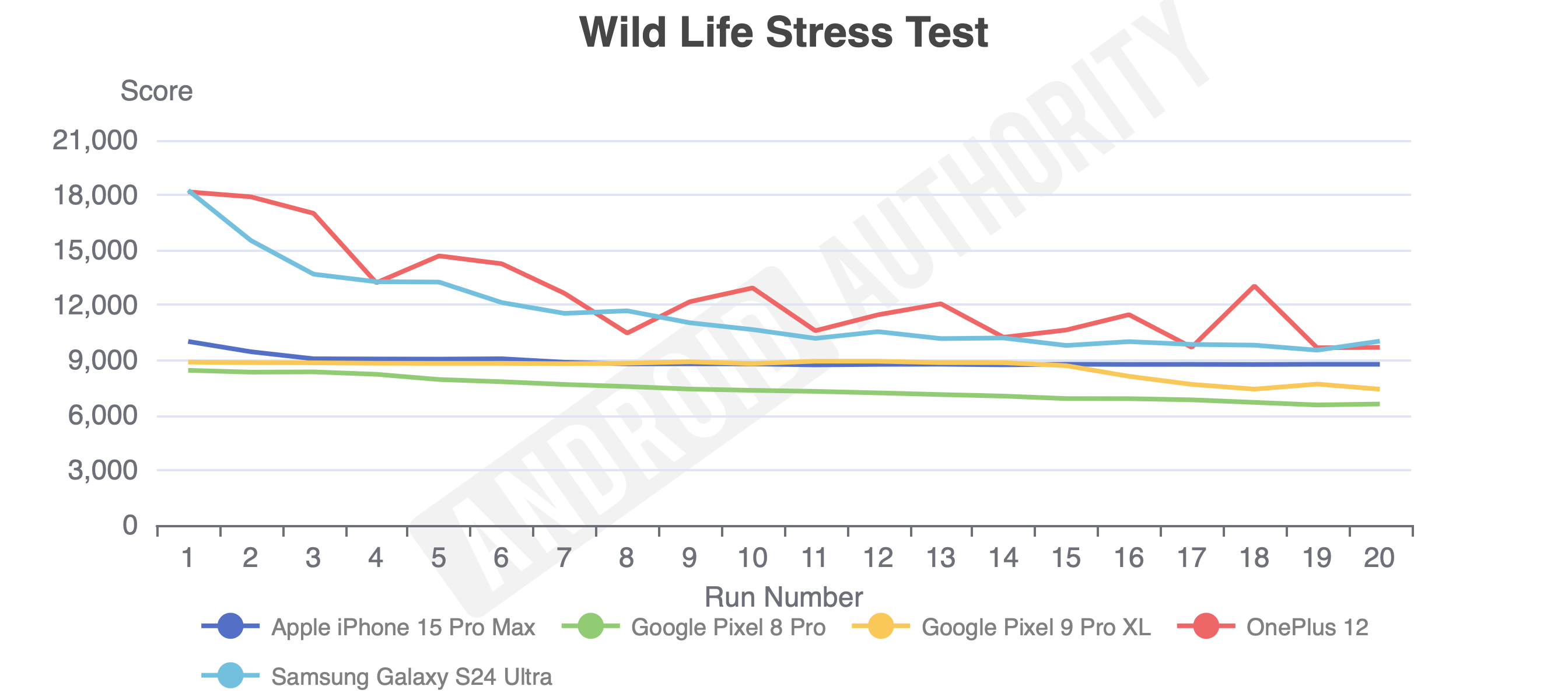
As usual, though, the Tensor G4’s raw numbers don’t make or break the experience. Most people simply won’t push their CPU or GPU hard enough on a given day to feel the difference against something like the Galaxy S24 Ultra. My dad, for example, was worried about the Pixel 9 Pro XL’s lower performance scores as a reason not to buy the phone, so I popped my SIM out and let him test drive it for a sunny day at Hersheypark. He put it through a standard day, checking baseball scores while waiting in line for rollercoasters and snapping photos while we tried to find shade with the animals in ZooAmerica, and left satisfied with the fact that Google can keep up with your average Joe.
I spent much longer with the Pixel 9 Pro XL, taking it to a Pittsburgh wedding and a soccer double-header in Washington, DC, but I reached the same conclusion. It pushed through a full 90 minutes (plus stoppage) of snapping photos from the cheap seats, then handled another hour or so of light gaming in Railbound and Ultimate Golf while waiting for the second game to start. My long days in the sun were enough to teach me one thing — the Tensor G4 still finds a way to run warm. I’ll chalk some of it up to the weather since it was around 85 degrees Fahrenheit, but the Pixel 9 Pro XL got toasty by the end of our Wild Life stress test, too, which is reflected in the sustained GPU performance drop between run 15-16, and suggests longer, intensive gaming sessions will eventually lead to throttling.
It might not benchmark like a Snapdragon 8 Gen 3, but the Tensor G4 is headed in the right direction.
Typically, thermal performance like that would have me very nervous about the Pixel 9 Pro XL’s battery life, but Google seems to have turned that corner, too. The 5,060mAh cell is only a hair larger than its predecessor, but it tops the Pixel 8 Pro across most metrics in our battery drain test by 30 minutes or more. It showed improvement across a simulated Zoom call, web browsing, snapping photos, and recording 4K video — things you’ll probably do most days. The Pixel 8 Pro handed in better 4K video playback and gaming battery life scores, though, which might come down to its slightly lower clock speeds being able to stretch its juice just a bit further.
Once again, in real life, the Pixel 9 Pro XL can go all day. I regularly went two days between charges, leaving my charger behind for back-to-back days of soccer and theme parks, and still reached my apartment in Baltimore with a little juice remaining.
When you eventually need a charge, the Pixel 9 Pro XL offers a little bit of a headache. Although Google upgraded the charging speeds across its entire non-folding Pixel 9 lineup, you can only reach them if you have a particular set of chargers. On paper, the Pixel 9 Pro XL supports up to 37W wired charging with up to 23W wireless charging from Google’s in-house second-generation Pixel Stand ($79 at Best Buy) or 12W wireless charging from any other pad.
I (incorrectly) assumed that this meant it would work with any old USB PD PPS-enabled charger, so I grabbed my trusty 68W Motorola TurboPower charger — a charger that I previously used to fill the Galaxy S24 Ultra at full power — and found that it wouldn’t go past 27W on the Pixel 9 Pro XL. So, I consulted the powers that be (our resident charging expert, Robert Triggs), snagged a more-than-capable upgrade off Amazon, and charged my Pixel 9 Pro XL a whopping two minutes faster than the Pixel 8 Pro.
That’s an oversimplification of the process, but it’s mostly true. The Pixel 9 Pro XL filled its battery in 77 minutes to the Pixel 8 Pro’s 79 minutes, but it was faster to every landmark along the way. Google’s newer flagship reached a 25% charge and a 50% charge seven minutes faster than its predecessor but then had to throttle a bit harder as it neared a full 100% to preserve the battery’s health and bring its thermals back in check. You can read our deep dive into the issue if you want a full breakdown, but the long and short of it is you’ll probably need a new charger for your Pixel 9 Pro XL if you want the very fastest recharge times, and even then, you’ll have to be careful about which one you buy.
But now, for the real reason that the Tensor G4 chipset matters because…
…it’s an AI powerhouse
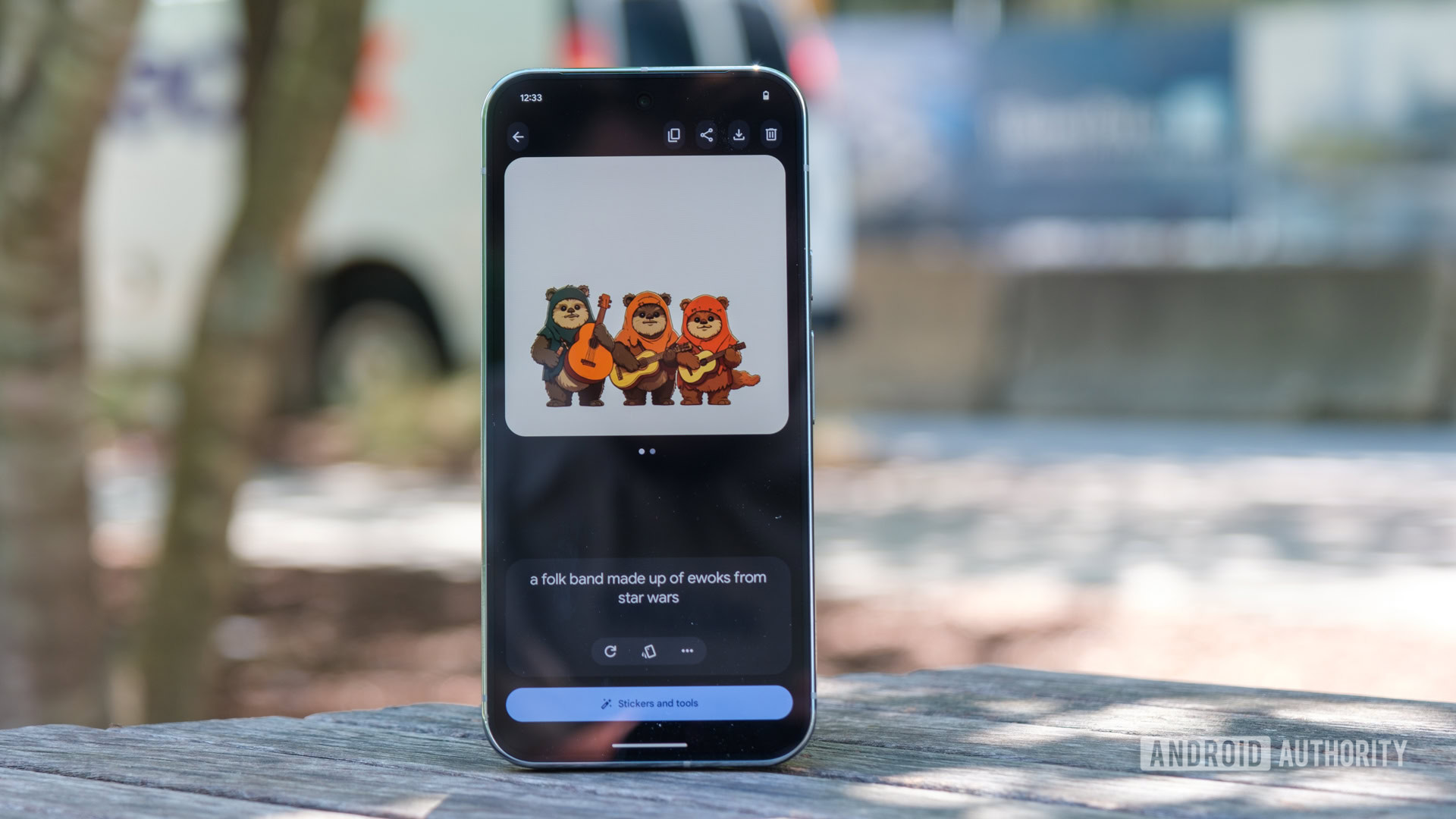
As Rick Osterloh said more times during Made By Google than Brian Johnson sang the word Thunderstruck while singing “Thunderstruck,” we’re in the Gemini age. And, as a longtime Pixel fan and Android user, I always knew this day was coming. I’ll readily admit that treating my phone like a gateway to AI has always made me nervous, and to an extent, it still does. I don’t know if I love having everything I do being used to train Gemini to take it off my hands, but that’s the world we live in.
For what it’s worth, though, Google’s Gemini-powered features are really good. Where many of them felt incomplete on the Pixel 8 Pro, like the artifact-laden Magic Editor, missing Zoom Enhance (which enjoyed a long-overdue launch on the same day as the Pixel 9 series), and the somewhat limited Gemini Assistant, they feel much more refined on the Pixel 9 Pro XL.
Gemini Assistant, for example, took a huge step further into the uncanny valley with the launch of Gemini Live, which gives the AI assistant a much more human-sounding voice and a much more conversational, easy-to-interrupt flow. I tried it both at Made By Google and once I returned home to Baltimore, and I was shocked at how human Gemini Live felt. It could listen to me pester it for afternoon plans in San Francisco and wasn’t bothered when I cut in to inform Gemini that I didn’t really want to spend much money or head to a museum. I even cross-referenced Gemini’s suggestions with C. Scott Brown, our resident Californian, and he was inclined to agree with the ideas. Currently, Gemini Live has about eight voices to choose from, ranging from very human to a little more generic, and I’ve been sticking to the generic end of the spectrum.
Outside of Gemini Live, I’ve spent the most time exploring Google’s new Pixel Studio — which is very different from Samsung’s Portrait Studio. At its heart, it’s a text-based image generator that lets your mind run wild for better or worse. I’ve enjoyed putting some of my favorite Star Wars characters into everyday situations, like playing in a non-cantina band or creating one-off graphics for my weekly run club. There’s a bit of a catch to that second idea, though — Pixel Studio won’t generate people at the moment. It’s likely for the safety of not putting political figures into compromising situations, but it also dampens the fun for those of us with good intentions.
I never thought I'd be hyping up an AI-powered weather forecast, but here we are.
The Gemini hits keep coming in Google’s updated Pixel Weather app. I’ve always liked Google’s approach to the weather, using a clean interface with a friendly frog at the top, but the revamped Pixel Weather app is on a different level. Sure, it still has your hourly and 10-day forecasts, but it now has an AI-generated weather report at the top, giving you a few quick reminders for the conditions. Sometimes, it’s helpful, like a reminder to grab sunscreen in case the clouds burn off later, while other times, it’s just letting you know that the weather outside is pleasant. Where it shines, though, is with the organizable widgets that live at the bottom of the interface. You can drag and drop everything from the wind direction to the UV index into whatever order you prefer, hiding the less useful metrics like visibility and pressure a bit further down.
These are just the Gemini-powered features I’ve found time to use — there are plenty more. Google has also given screenshots a taste of its AI magic, allowing you to organize and search through them like a giant Pinterest board. The Pixel 9 Pro XL lets you save information from phone calls with its new Call Notes feature, too, but I tend to lose digital notes faster than physical ones, so I’ve skipped out on that feature. Google is also in the process of launching additional scam protection features, which will give you faster indications if a call or text message appears to be dangerous. You’ll then have the option to approve the message or delete it permanently.
And, because it’s a Pixel device with an update promise of seven years (covering Android versions, security patches, and Pixel Drops), there’s probably a long list of AI-powered features we’ve yet to hear about that will make their way to the Pixel 9 Pro XL. I still can’t wrap my head around why Google launched its Pixel 9 series with Android 14 rather than wait until Android 15 was ready — even if the new Pixel apps make it feel more like Android 14.5. But these days, that’s not a valid issue anymore. Android 15 made its way to the Pixel 9 Pro XL (and the rest of the Pixel 9 series) shortly after launch, and my phone has since received updates through the February 2025 security patch.
Four cameras, no weaknesses
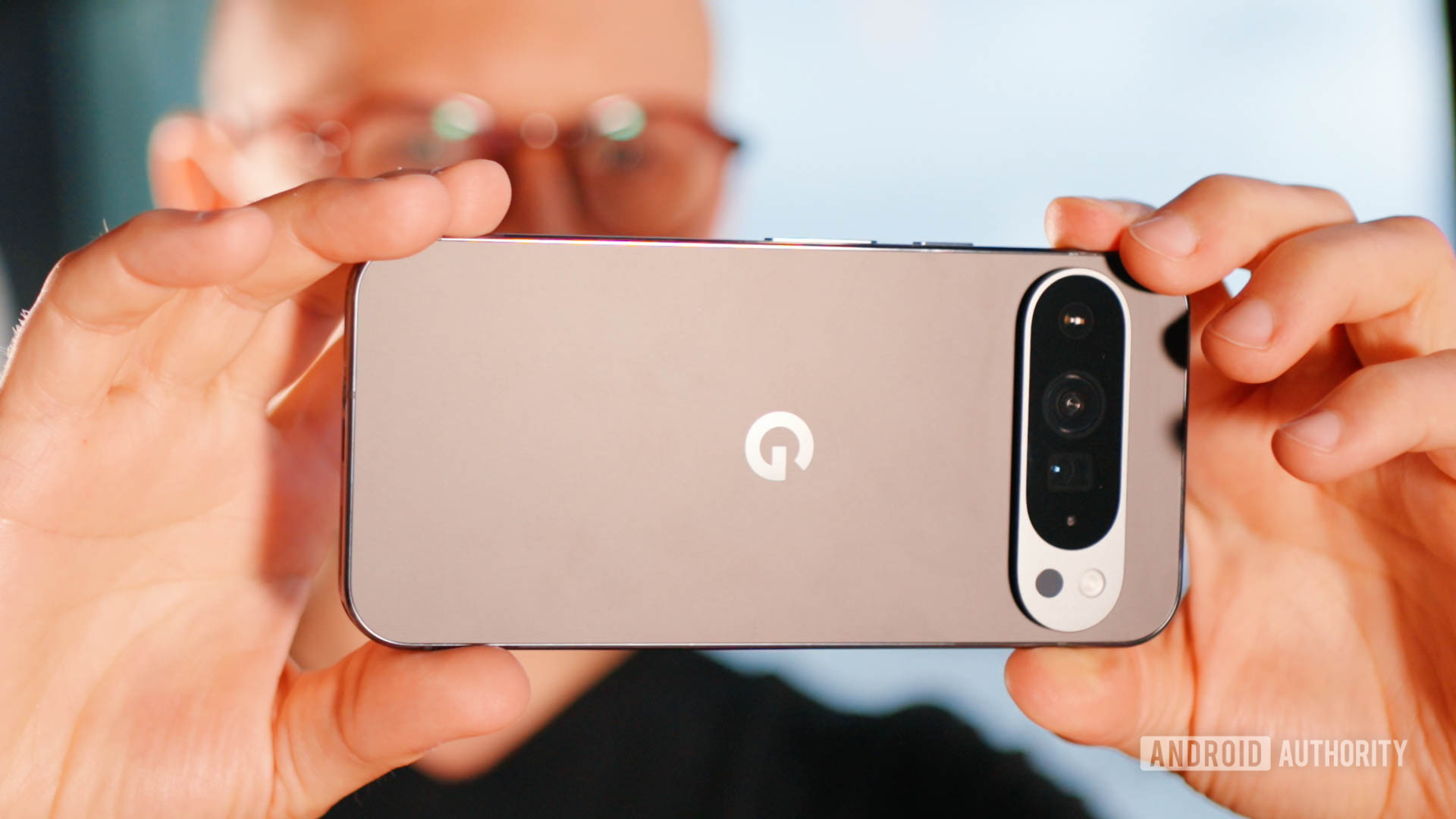
Now, for the moment that longtime Pixel fans have been waiting for — the cameras. I still have fond memories of the 12.2MP and 16MP pairing from the back of my Pixel 5, but it’s clear that those days are long, long gone. That small, square camera bar has since stretched into an edge-to-edge camera bar to fit a third sensor, and now it’s shrunk into a pill-shaped island but kept the same position among the best camera phones around.
Regarding sensors, the Pixel 9 Pro XL isn’t much different from its predecessor. It packs the same 50MP primary camera with a shallow maximum aperture of ƒ/1.7 and the equivalent of a wide 25mm focal length, and it’s still backed by a 48MP periscope telephoto that offers 5x optical zoom. This year, though, Google swapped out its 48MP ultrawide sensor, picking up the same ƒ/1.7 maximum aperture as its primary sensor but shrinking slightly to a 123-degree field of view. It’s a small change that you’re not terribly likely to notice — but the extra light capture should help those who love Google’s software-based macro mode.
Once you get the Pixel 9 Pro XL out into the real world, you realize that this isn’t the same camera setup you saw on the Pixel 8 Pro. Where I often use the primary sensor for the bulk of my shooting, I found myself much more willing to rely on Google’s tighter telephoto sensor on the Pixel 9 Pro XL, punching into 5x zoom and beyond while watching Chelsea FC Women beat Arsenal FC Women in a pre-season friendly. Even Google’s maxed-out 30x Super Res Zoom is impressive, capturing significantly better detail than its predecessor thanks to updated image processing. Let’s get to the shots, and you’ll see what I mean.
In previous years, I never would have put a 10x zoom image in the first row of a review gallery. I’m used to them quickly giving up on details, even on a flagship-grade setup. This time, though, the Pixel 9 Pro XL blew me away. I stood under the stairs to the upper deck at Audi Field and punched in on the flag waving by the Chelsea goal. It might be missing a few textures within the folds of the flag, but the colors are spot-on, the details are sharp, and you can easily make out the Arsenal fans in the far background with their red shirts and white sleeves. The Pixel 9 Pro XL handled a much wider scene without issue, too, perfectly recreating the afternoon sky above the west side of Audi Field with its whispy clouds and not-quite-blue coloring.
Once again, the Pixel 9 Pro XL nails the colors across all four shots above — in sunny conditions and just a few minutes before rain. The macro shot of the white flowers is barely a true macro image since I couldn’t hold them still enough for a good shot, but it at least shows off the shallow depth of field that the Pixel 9 Pro XL’s camera can achieve, keeping the first few flowers in focus but falling off nicely as you reach the water in the background. If I have one complaint from this set, it’s that Google didn’t achieve even lighting across the neon sign, with the C in YMCA missing the glow that the other letters have.
The Pixel 9 Pro XL can handle low-light shooting with excellent detail, too, thanks to the size of its primary sensor. I captured the first two images, with my colleague Paul Jones adding the third, and all three show different strengths of the phone. I particularly like that the Pixel captured the slow change in the color of the sky to the left while still holding onto a few of the clouds right near the lightbulbs. You can still pick out details in the brick building, too.
The middle image barely counts as night mode, thanks to the lights of Baltimore’s Inner Harbor, but it does show how far the Tensor G4 can stretch the light it captures. You can easily identify each rope in the rigging, and the black-painted boards on the ship’s side are still distinct despite the dark coloring and even darker water.
Punching out, the Pixel 9 Pro XL’s ultrawide camera puts me in an interesting spot. Yes, the images all look crisp and free from distortion, but there’s not much ultra in this ultrawide. Google’s sensor only punches out to 0.7x, which isn’t quite as wide as Samsung’s 0.6x or Apple’s 0.5x. I still think the Tensor G4 nailed the colors across all four, and the details around the edges are spot-on, but I would have appreciated a bit more of an angle.
Zooming in, though, the Pixel 9 Pro XL is simply excellent. I’d typically dismiss shots taken beyond 5x zoom, but this time, I happily shared shots from the 10x to 15x range on my Instagram story — both at an Orioles game and while watching soccer. Google’s 5x optical zoom plays a huge role in this quality, of course, essentially starting it on third base when you punch into 10x zoom or more and letting the Tensor G4 bring it home. I don’t think I’d zoom in much closer on the 30x image as the details get pretty soft, but it’s impressive how sharp the rows of club seats and the announcers in the box are when taken at face value.

Of course, what Pixel flagship would be complete without software features, right? Up first, Google reimagined its panorama mode. I know it might not sound terribly exciting — most people shoot a panorama once and never come back to it — but the Pixel 9 Pro XL makes it so much easier. Rather than guide your phone between two tight lines, you simply shift along the horizon, briefly pausing inside glowing yellow circles while the phone grabs an image. Once you’re done, it stitches them together for smooth shots like the one above. It does seem to struggle with objects in the foreground, though, so there’s still a little bit of ironing out to be done.
Google also finally launched Zoom Enhance just about a year after it was first announced. Frankly, I see why it took so long. There are some areas in both of the shots above where Zoom Enhance seems to work well, like Aubrey Kingsbury’s right leg and ponytail, but there are just as many where it struggles, like with her name on the back of her shirt and with just about all of Trinity Rodman’s hair. But hey, it made that grass look like really sharp grass, right?
There’s still a lot of potential for Zoom Enhance to get better over time, and I’m sure it will do just that with frequent updates — it’s just not quite there yet.

And then, there’s Add Me, which does just that — adds you (or a friend) to a photo so that nobody has to miss out on a chance encounter with a celebrity or a family photo. It also works for any version of the pointing Spider-Man meme that you can come up with, as seen above. Add Me seems to need a relatively varied background to work properly, though, as simple backgrounds tend to confuse its sense of scale, making one person much bigger than another in a shot.
Google also offers a wide range of other AI-powered tools you can explore on the Pixel 9 Pro XL, like the ability to completely change your photos with the Reimagine feature in Magic Editor. I’ve tried to turn the Ikea chair that my cats sleep on into a boat on choppy waters a few times now with mixed results, but I’ll say that longer-standing tools like Magic Eraser show clear signs of maturity, with fewer artifacts and smoother replacements.
One other camera that I haven’t mentioned so far is Google’s updated selfie shooter. The Pixel 9 Pro XL now has a whopping 42MP punch hole in its 6.8-inch display, and it makes the most of its hardware. I didn’t think it would be significantly better than the Pixel 9’s standard 10.5MP selfie camera, but Google’s top-end Pixel handed in better details and more accurate colors across several different shooting scenarios. It also defaults to 1x zoom, but I prefer the digital 0.7x ultrawide angle to fit more of my background in the shot.
Finally, I think Google is after Apple’s crown as the king of smartphone videos. It now supports Video Boost for clips at up to a maximum of 20x Super Res Zoom, either day or night, and can also upscale your clips to 8K resolution, from which you can pull 33MP still images. Mix in Google’s already excellent stabilization, and the only thing that’s missing is to shoot in Log format to color-grade later. I’m not an amateur cinematographer, though, so I’m pleased with Google’s default color profile when sharing clips. Besides, you still get cinema-like features like Pan and Blur for steady sweeping shots and a soft, movie-like focus on your subjects.
If there’s one piece of Google’s video setup that’s not quite there, though, it’s the Gemini-powered Audio Magic Eraser. I tested it against Samsung’s version of the feature while on a trip to my local climbing gym and found that although it handled some noise pretty well, it mostly muffled sharp sounds and occasionally had trouble separating background music from people speaking.
You can also check out full-resolution versions of these shots (and many more from myself and other testers at Android Authority) at this Google Drive link.
Google Pixel 9 Pro XL review verdict: This is what I’ve waited for
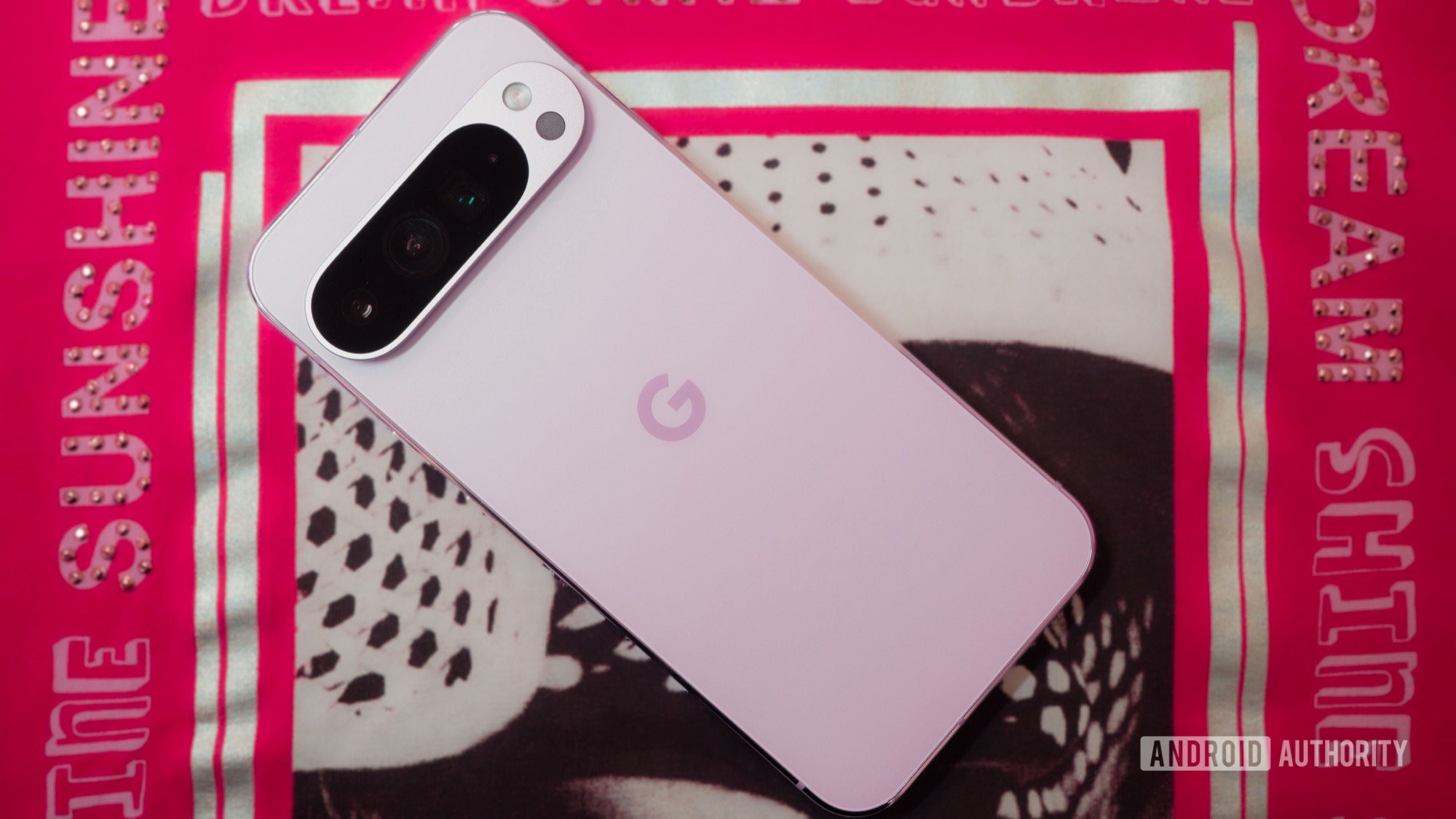
As you’ve probably guessed, I really, really like the Pixel 9 Pro XL. Despite the review score I’ve given it, it’s not perfection; nothing ever is. The Tensor performance upgrades look to be reserved for the Pixel 10, and the charging situation is… confusing. But neither of these are dealbreakers for me, and I don’t think they should be for you, either.
The Pixel 9 Pro XL feels like the elite flagship phone Google has been building up to ever since it brought its chipset production in-house, combining best-in-class software updates with refined hardware and a unique design that are both better than ever. And yes, I know I said almost the same exact thing about the Pixel 8 Pro when I reviewed it, but I promise you that the Pixel 9 Pro XL is all that but better — even if it costs $100 more.
Suppose you had told me, back when I was checking out my roommate’s Pixel XL, that one day, Google would have a flagship with better hardware than the iPhone, three incredibly capable, AI-powered cameras, genuinely good battery life, and that it would receive software updates into the start of the 2030s. In that case, I might have laughed at you. It might have sounded like my dream, but my reality was a Pixel with one 12.3MP camera, chunky top and bottom bezels, and just a few years of updates on the horizon. I thought Google would give up on its Pixel series before it reached this point, but now I wonder how it will improve for the next generation. Somewhere out there, this is a kid’s first Pixel, and they have no idea what they missed.
This is the phone I always wanted Google to make, but was never sure it could.
Oh, and if you happen to think that the massive Pixel 9 Pro XL is too much phone for you, Google has a solution: the smaller Pixel 9 Pro ($999 at Amazon). It packs much of the same Google-y goodness with Gemini features, camera smarts, and high-end hardware as the Pixel 9 Pro XL, just compressed into a 6.3-inch body. There are some trade-offs, like a smaller battery and slower charging, but I’d say they’re worth it for what might be the most capable small Android phone in a long time, and I’ve only just begun using it at the time of writing this review.
And yet, I don’t think everyone will like the Pixel 9 Pro XL. It’s an excellent phone in a crowded market of fantastic phones, and it’s harder than ever to pull someone out of their preferred ecosystem. Samsung’s Galaxy S25 Ultra ($1299.99 at Amazon) is the Pixel’s most natural rival, offering a similar 6.9-inch display that finally does away with its boxy top and bottom edges. It’s a power user’s dream, pairing Qualcomm’s powerful Snapdragon 8 Elite for Galaxy chipset with a pared-back S Pen and running its quad-camera setup back for another year. If there’s one problem with the Galaxy S25 Ultra, though, it’s an incredibly large phone that’s less comfortable to hold than its predecessor… and many of its new Galaxy AI features can be had for less money anyway.
Samsung has its share of Galaxy AI features, too, with things like Note Assist to organize your handwriting into an easily readable document and Photo Assist to clean up your photos, kind of like the Magic Editor. Although if you think the Pixel 9 Pro XL is too big, the Galaxy S24 Ultra feels even bigger, its sharper corners make it less comfortable to slip into a pocket, and its AI push isn’t quite as mature as Google’s. It’s also more expensive even with Google’s price hike.
One other option for users who want an Android flagship but are looking for something a little bit different is the OnePlus 13 ($899.99 at OnePlus). It’s easily the best OnePlus flagship in years, pairing a beautiful design with a newly flattened display and packing it with the powerful Snapdragon 8 Elite chipset — just not the overclocked version that Samsung has. Other highlights of the OnePlus 13 include blistering fast wired charging (with a charger in the box), the best Hasselblad-tuned camera to come out of the five-year partnership, and a much cleaner version of Oxygen OS that feels like a return to OnePlus’s roots.
And then, for those who aren’t dead-set on Android, there’s the iPhone 16 Pro Max ($1199 at Amazon). Physically, it’s probably the phone that feels the most like the Pixel 9 Pro XL, right down to its flat sides and the placement of its antennas. Of course, you’ll have to accept iOS and find your way into Apple’s walled garden, which can be an expensive change to make, but you’ll also get to explore Apple Intelligence from the day it’s launched, and Apple’s manual Camera Control adds a convenient way to control your camera settings on the fly. But really, with Google’s seven years of updates and much-improved battery life, is being a blue bubble much of a selling point over the Pixel 9 Pro XL these days?

